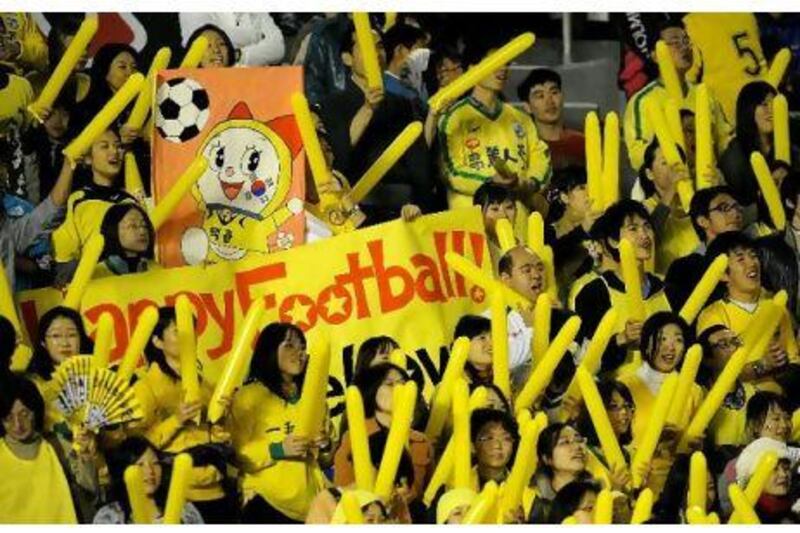[ Fifa Under 17 World Cup in 2013 is awarded to UAE ]
The comparison isn't so much apples and oranges as apples and elephants. The Asian Champions League and Uefa Champions League share two-thirds of a title but nearly nothing else.
No sentient football fan in Asia would argue the point, assuming they could be prised away from televised Uefa Champions League matches long enough to consider the topic.
The same people soaking up Arsenal against Barcelona may be only dimly aware that their own continent has a 32-side club competition, which began four days ago. But we already know that long swathes of Asia, from the UAE to Malaysia, follow the Premier League as avidly as anyone living in Surrey or Kent.
The numbers tell the tale. Recent Champions League finals have been seen by around 110 million television viewers, the Asian Champions League (ACL) by less than one per cent of that total. A full house of 80,100 saw the 2010 Uefa final in the Bernabeu in Madrid; 27,308 were at the ACL final at National Stadium in Tokyo, capacity 48,000.
And money? A season-ending match between Manchester City and Tottenham Hotspur last May, upon which a Champions League berth hinged, was dubbed the "£50 million match" (Dh298m), because that was the additional revenue the winner could expect.
The value of a berth in the ACL hovers not far north of zero, unless a team manages to win the tournament. In that case, it may have banked about US$2.3m (Dh8.4m), $1.5m from the championship match. In Europe, clubs are awarded €3.9m (Dh20m) just for reaching the 32-team group stage.
We know the score now. But will the ACL be Uefa's little brother … forever?
If recent history is any indication, the answer is "no".
Asia is home to more than half the world's seven billion-plus people. It now boasts two of the world's three biggest economies, in China and Japan, and India is on the cusp of giving the continent three of the top 10. That means lots of eyeballs with rising incomes.
Someday, Asia will have elite clubs of its own, and its own avidly followed continental club competition. Or so Carlo Nohra, believes.
Nohra is the chief executive of the Pro League in the UAE and a former director of competitions at the Asian Football Confederation (AFC). He believes that Asia has a "keen desire to replicate the European experience", and that includes consuming local football.
"We already see Asians wearing suits and embracing Western lifestyles," he said. "Louis Vuitton probably sells more handbags in Tokyo than it does in Paris. Football may take longer to make the jump, but I believe it will."
The ACL already has much to recommend it, even if it is a semi-solitary pastime. Real and fascinating differences in style and tactics exist in such a vast region.
To see Al Wahda play host to Bunyodkor of Uzbekistan this week was to watch high-pressure, semi-mechanical Soviet-style football against a more technical but leisurely UAE template. (To run hard for 90 minutes is madness in the Gulf.)
The Asian tournament also has made a jump in quality. Stricter requirements for entry have eliminated weaker sides from Syria, Kuwait, Iraq, Vietnam and Thailand, countries which received free passes into the ACL as recently as 2008.
The current ACL skews heavily toward the six strongest leagues on the continent, those in Japan, South Korea and China, in the east; and Iran, Saudi Arabia and the UAE in the west. Among them, those six countries account for 24 of the 32 clubs in this year's tournament, with Australia, Indonesia, Qatar and Uzbekistan making up the balance.
The AFC would love to see sides from India and Malaysia in the final 32, but they must earn their way. The ACL has become a meritocracy, and that means tougher competition, as well as a well-defined target for lesser leagues.
Sponsorship, too, is surging. The Singapore-based World Sports Group, to name one buyer, spent $10m for its AFC ties in 1992, Nohra said. For the period from 2013 through 2020, that figure will have risen to nearly $1 billion.
UAE sides will not discount the rigours of the new ACL. In the first round, Al Jazira and Wahda were held to home draws; Al Ain lost at home to FC Seoul; plucky Emirates fell 2-1 away to Zob Ahan of Iran.
Few Asian clubs have more than three decades of history, yet some of the newest are rocketing to prominence as well-heeled directors focus on taking their clubs to new heights. Today, Asia. Tomorrow, the world?
Fifty years hence, might Britons and Germans and Italians and Spaniards be watching the Asian Champions League avidly to see many of their best players compete for Al Hilal and Sepahan and Gamba Osaka and Beijing Gouan?
Do not discount the possibility.
"I have lived and worked in Asia, and I know what has been accomplished," Nohra said. "I know Asians want to achieve these things, and they have done it in the world outside football. Soon enough they will do it there, too. It's a tall order, but they will do it."
Europeans, he said "can laugh" at the idea of the ACL rivalling the Champions League. "But they take Asia lightly at their peril."





